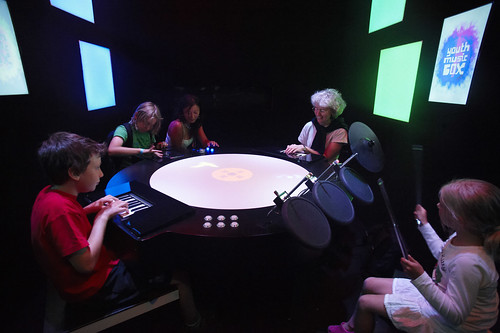
Ten minutes. Four or five kids (or adults). Make a song. Go.
That’s the idea behind the Youth Music Box, developed by Silent Studios and Chris O’Shea. (Our friend Chris you may recall from various interactive projects and the blog pixelsumo; he sends this project our way.) The software is build in openFrameworks, the C++-based creative coding environment for artists.
With keys, drums, and yes, even a scratching DJ-style interface, the music box brings together kids for quick music making, inspired by the phenomenon of musical games. The experience is guided by genre, with some effort to make sure whatever they do sounds good, but it’s extraordinary how effective it is at conveying the experience of the successful jam. It’s a bit of a confidence builder, in other words, for a group musical experience, perhaps more so than those ear-splitting, cheap plastic recorder consorts I recall from my youth.
And oh yeah, those kids look super cute once they get rocking out. (See video below.)
Youth Music Box Experience from Silent Studios | Resonate on Vimeo.
Youth Music Box Experience from Silent Studios | Resonate on Vimeo.
All of this raises some fascinating questions, and not always with the answers you might expect. In a normal musical ensemble, you begin sounding like crap, amp up difficulty, and eventually sound something like this – at least as far as coherence goes, assuming you’re not aiming for experimental free jazz. But with the addition of technology, whether musical games or the presets on our favorite synths or the quantization and beat-synced loops of our sequencers, it goes something in reverse. You start out sounding like this, pull apart the mechanisms that make you sound a certain way, and eventually find your way to your own personal approach. (And at some point, you get some of the readers on this site, writing code to produce their own sounds and musical structures line by line.) In fact, one could imagine scaling difficulty of even this particular setup, gradually adding greater musical freedom and taking away the “training wheels” of all the rules-based restrictions that make the results sound a particular way.